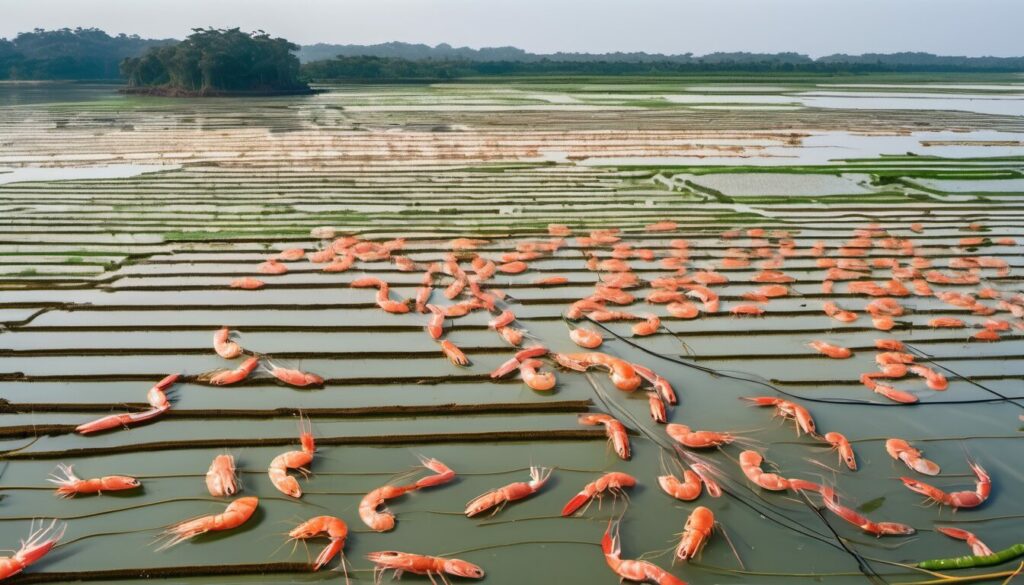Shrimp farming, a cornerstone of the aquaculture industry, is undergoing a transformation propelled by innovative technologies and practices. These advancements are not only enhancing productivity and efficiency but also promoting sustainability and environmental stewardship. In this article, we delve into the cutting-edge innovations that are revolutionizing shrimp farming, shaping the future of this vital sector.
Recirculating Aquaculture Systems (RAS):
In the realm of shrimp farming, innovation is key to meeting the ever-growing demand for seafood while minimizing environmental impact and ensuring sustainability. Among the myriad of advancements, recirculating aquaculture systems (RAS) stand out as a game-changer in revolutionizing shrimp cultivation.
Understanding Recirculating Aquaculture Systems (RAS):
Recirculating aquaculture systems (RAS) represent a paradigm shift in shrimp farming methodology. Unlike traditional open pond systems, RAS facilities are designed to create a controlled environment that optimizes water quality, temperature, and oxygen levels for shrimp cultivation. Advanced filtration and water treatment technologies are integral components of RAS, ensuring the maintenance of optimal conditions essential for shrimp health and growth.
Key Components of RAS:
At the core of RAS technology lies a closed-loop system that continuously recirculates water within the facility. Water is passed through a series of filtration units, including mechanical, biological, and chemical filters, to remove solid waste, organic matter, and harmful pathogens. Additionally, water treatment processes such as UV sterilization and ozonation are employed to further purify the water and eliminate disease-causing agents.
Benefits of RAS:
The adoption of RAS technology offers a plethora of benefits for shrimp farming operations. By minimizing water usage and discharge, RAS facilities significantly reduce environmental impact and resource consumption compared to traditional pond-based systems. Moreover, the controlled environment of RAS helps mitigate the risk of disease outbreaks, as pathogens are less likely to proliferate in clean, well-maintained water. This results in higher survival rates, faster growth, and improved product quality, ultimately enhancing the profitability and sustainability of shrimp farming enterprises.
Environmental Sustainability:
Environmental sustainability is a cornerstone of RAS technology. By minimizing water usage and discharge, RAS facilities alleviate pressure on freshwater resources and reduce pollution of waterways and coastal habitats. Additionally, the controlled environment of RAS mitigates the environmental impact of shrimp farming by minimizing habitat disturbance and preserving ecosystem integrity. As a result, RAS represents a more environmentally sustainable approach to shrimp cultivation compared to traditional farming methods.
Economic Viability:
In addition to environmental benefits, RAS technology offers significant economic advantages for shrimp farmers. The ability to control production parameters such as water quality, temperature, and feeding regimes enables farmers to optimize production efficiency and maximize yield. Higher survival rates, faster growth, and improved product quality translate into increased profitability and competitiveness in the global market. Moreover, the scalability and versatility of RAS technology make it suitable for a wide range of production scales, from small-scale operations to large commercial enterprises.
Challenges and Considerations:
Despite its numerous benefits, the adoption of RAS technology presents certain challenges and considerations for shrimp farmers. Initial capital investment and operational costs associated with the setup and maintenance of RAS facilities can be significant, particularly for small-scale producers. Additionally, technical expertise and specialized knowledge are required to operate and manage RAS systems effectively. Furthermore, energy consumption and environmental footprint associated with RAS technology must be carefully managed to ensure long-term sustainability and cost-effectiveness.
Future Outlook:
Looking ahead, the future of shrimp farming lies in the widespread adoption and further advancement of RAS technology. As consumer demand for sustainably sourced seafood continues to rise, RAS offers a viable solution to meet this demand while minimizing environmental impact and ensuring long-term sustainability. Continued research and innovation in RAS technology hold the potential to further enhance production efficiency, reduce operating costs, and improve environmental sustainability. By embracing RAS technology, shrimp farmers can position themselves at the forefront of the industry and pave the way for a more sustainable and prosperous future.
Recirculating aquaculture systems (RAS) represent a transformative innovation in shrimp farming, offering a sustainable and environmentally friendly alternative to traditional production methods. By creating a controlled environment that optimizes water quality, temperature, and oxygen levels, RAS technology enables shrimp farmers to achieve higher survival rates, faster growth, and improved product quality. Moreover, RAS helps minimize environmental impact by reducing water usage, discharge, and pollution, ultimately contributing to the long-term sustainability of shrimp farming operations. As the industry continues to evolve, RAS technology is poised to play a central role in shaping the future of shrimp farming, ensuring its viability and resilience in the face of environmental challenges and changing consumer preferences.
Selective Breeding and Genetic Improvement:
In the realm of shrimp farming, selective breeding and genetic improvement programs are driving significant advancements, revolutionizing the industry’s approach to productivity, sustainability, and resilience.
Selective Breeding: A Key Driver of Genetic Improvement
Selective breeding is a time-honored practice in agriculture and aquaculture, aiming to enhance desirable traits in livestock and cultivated species. In shrimp farming, selective breeding involves the careful selection of breeding stock with specific characteristics such as fast growth, disease resistance, and high survival rates. By mating individuals with superior traits, shrimp farmers can propagate offspring with improved genetic potential, leading to enhanced productivity and profitability in subsequent generations.
Advanced Genetic Techniques: Accelerating the Breeding Process
Advancements in genetic technology have revolutionized selective breeding practices, enabling shrimp farmers to accelerate the breeding process and achieve more precise outcomes. Techniques such as marker-assisted selection (MAS) and genomic selection allow breeders to identify and select individuals with desired genetic traits more efficiently. By analyzing genetic markers associated with target traits, breeders can make informed decisions about breeding pairings, resulting in faster genetic gains and more predictable outcomes.
Benefits of Genetic Improvement Programs
Genetic improvement programs offer a multitude of benefits for shrimp farming operations. By developing strains with superior traits such as fast growth, disease resistance, and high survival rates, farmers can achieve higher yields and improved profitability. Moreover, genetically improved shrimp stocks are better adapted to farming conditions, resulting in reduced mortality rates and increased resilience to environmental stressors. Additionally, genetic improvement programs help reduce the industry’s reliance on wild-caught broodstock, promoting sustainable aquaculture practices and conserving wild shrimp populations.
Promoting Genetic Diversity: A Priority in Breeding Programs
Maintaining genetic diversity is essential for the long-term sustainability and resilience of shrimp farming operations. Genetic improvement programs prioritize genetic diversity by carefully managing breeding populations and avoiding excessive selection pressure on specific traits. By preserving genetic diversity, breeders can minimize the risk of inbreeding and genetic bottlenecks, ensuring the continued adaptability and robustness of shrimp stocks in the face of evolving environmental conditions and emerging threats.
Challenges and Considerations
Despite their numerous benefits, genetic improvement programs in shrimp farming face certain challenges and considerations. Balancing selection for desirable traits with maintaining genetic diversity requires careful management and monitoring to prevent unintended consequences such as loss of genetic variability or emergence of undesirable traits. Additionally, genetic improvement programs require significant investments in infrastructure, expertise, and research and development, which may pose barriers to adoption for small-scale producers.
Future Outlook
Looking ahead, the future of shrimp farming lies in the continued advancement and adoption of genetic improvement programs. As consumer demand for sustainably sourced seafood grows, genetically improved shrimp stocks offer a viable solution to meet this demand while enhancing productivity, profitability, and environmental sustainability. Continued research and innovation in genetic technology hold the potential to further optimize breeding programs, leading to the development of shrimp stocks with even greater resilience, productivity, and market appeal.
Selective breeding and genetic improvement programs are revolutionizing the shrimp farming industry, offering a sustainable and efficient approach to enhancing productivity, profitability, and environmental sustainability. By harnessing the power of advanced genetic techniques, shrimp farmers can develop strains with superior traits, resulting in higher yields, reduced environmental impact, and increased resilience to environmental stressors. As the industry continues to evolve, genetic improvement programs will play a central role in shaping the future of shrimp farming, ensuring its viability and resilience in the face of evolving challenges and opportunities.
Alternative Feed Formulations:
As the demand for seafood continues to rise, shrimp farming faces increasing pressure to adopt sustainable practices. Among the innovative solutions emerging in the industry, alternative feed formulations are playing a pivotal role in reducing the environmental impact of shrimp farming while promoting long-term sustainability.
Traditionally, shrimp feeds have relied heavily on fishmeal and fish oil, derived from wild-caught fish stocks. However, this practice has led to overfishing and depletion of marine resources, posing significant challenges to the health of aquatic ecosystems. In response, shrimp farmers are turning to alternative feed ingredients sourced from sustainable and eco-friendly sources.
Advancements in feed formulation have paved the way for the development of feeds based on plant proteins, algae, and insect meal. These alternative ingredients offer a more sustainable and environmentally friendly alternative to traditional fish-based feeds. By reducing reliance on wild fish stocks, alternative feeds help alleviate pressure on marine ecosystems and contribute to the conservation of biodiversity.
Moreover, alternative feeds are not only eco-friendly but also offer nutritional benefits for shrimp. They are rich in essential nutrients and amino acids, promoting healthy growth and enhancing shrimp health and resilience. Additionally, alternative feeds have been shown to improve feed efficiency, resulting in higher growth rates and reduced production costs for shrimp farmers.
Alternative feed formulations represent a promising solution to the sustainability challenges facing the shrimp farming industry. By embracing these innovative practices, shrimp farmers can reduce their environmental footprint, conserve marine resources, and ensure the long-term viability of their operations. As the industry continues to evolve, alternative feed formulations will play an increasingly important role in promoting sustainability and resilience in shrimp farming.
Integrated Multitrophic Aquaculture (IMTA):
Shrimp farming is undergoing a transformation, driven by the urgent need for sustainability and environmental stewardship. Integrated Multitrophic Aquaculture (IMTA) stands out as a beacon of hope in this endeavor, offering a holistic approach to shrimp cultivation that prioritizes ecological sustainability, resource efficiency, and resilience.
Understanding Integrated Multitrophic Aquaculture (IMTA):
Integrated Multitrophic Aquaculture (IMTA) is a pioneering farming technique that leverages natural processes to create a balanced and sustainable aquatic ecosystem. In IMTA systems, multiple species are cultivated in proximity, forming symbiotic relationships where the waste products of one species serve as nutrients for another. For example, shrimp ponds can be integrated with seaweed or bivalve culture, which absorb excess nutrients and improve water quality. By harnessing natural processes and maximizing resource utilization, IMTA systems minimize environmental impact, enhance ecosystem resilience, and diversify farm outputs.
The Benefits of IMTA:
IMTA offers a multitude of benefits for shrimp farming operations, the environment, and surrounding communities. By reducing waste and nutrient pollution, IMTA mitigates the environmental impact of shrimp farming, contributing to cleaner waterways and healthier ecosystems. Moreover, IMTA enhances farm productivity and profitability by diversifying outputs and reducing input costs. Seaweed and bivalve cultivation in IMTA systems provide additional revenue streams and market opportunities for farmers. Additionally, IMTA promotes social sustainability by creating employment opportunities and supporting local economies.
Challenges and Considerations:
Despite its numerous benefits, IMTA implementation poses certain challenges and considerations for shrimp farmers. Designing and managing IMTA systems require specialized knowledge and expertise in aquaculture, ecology, and engineering. Additionally, site selection, species compatibility, and regulatory considerations must be carefully evaluated to ensure the success and sustainability of IMTA operations. Moreover, scaling up IMTA from small-scale pilot projects to commercial operations may require significant investments in infrastructure, research, and development.
Future Outlook:
Looking ahead, the future of shrimp farming lies in the widespread adoption and further advancement of IMTA technology. As consumer demand for sustainably sourced seafood continues to rise, IMTA offers a viable solution to meet this demand while minimizing environmental impact and ensuring long-term sustainability. Continued research and innovation in IMTA technology hold the potential to further optimize system design, species selection, and management practices, leading to the development of highly efficient and resilient IMTA systems.
Integrated Multitrophic Aquaculture (IMTA) represents a paradigm shift in shrimp farming, offering a holistic and sustainable approach to cultivation that balances economic, environmental, and social objectives. By harnessing the power of natural processes and maximizing resource utilization, IMTA systems hold the promise of a thriving shrimp farming industry that benefits both people and the planet. As we continue to explore and embrace innovative solutions like IMTA, the future of shrimp farming looks brighter than ever, promising a sustainable and resilient industry that nourishes communities and ecosystems alike.










More Stories
Beyond the Plate: The Environmental, Economic, and Social Impact of Global Food Waste
Balancing Act: Aquaculture’s Impact on Biodiversity Conservation
Onions: Trends and Opportunities in the Global Market